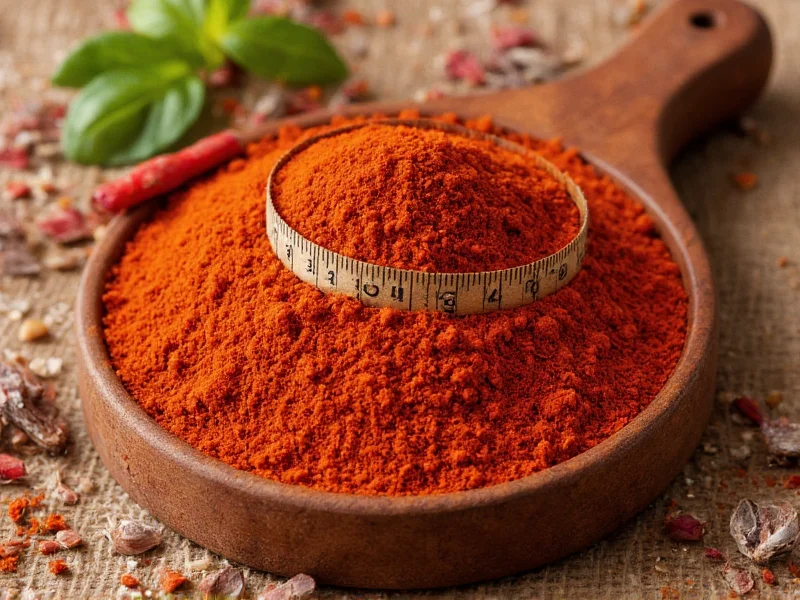When exploring what is the measurement of spice, it’s essential to understand that “spice” refers to ingredients, not a unit of measurement. Culinary professionals and home cooks measure spices using standardized units to ensure recipe accuracy and consistent flavor outcomes. This guide clarifies common measurement systems, conversion methods, and practical tips for precise spice usage.
Standard Spice Measurement Units
Chefs and recipe developers primarily use three measurement systems for spices:
| Measurement Type | Common Units | Best For |
|---|---|---|
| Volume Measurements | Teaspoon (tsp), Tablespoon (Tbsp), Cup | Home cooking, quick recipes |
| Weight Measurements | Grams (g), Ounces (oz) | Professional kitchens, baking, spice blends |
| Descriptive Measurements | Pinch, Dash, Smidgen | Adjusting to taste, traditional recipes |
Why Precision Matters in Spice Measurement
Unlike staple ingredients, spices have concentrated flavors that significantly impact dishes even in small quantities. A teaspoon measurement for spices can mean the difference between a balanced dish and an overpowering one. Ground spices pack more densely than whole spices, requiring different measurement approaches. For example:
- 1 teaspoon of ground cinnamon weighs approximately 2.6 grams
- 1 teaspoon of whole cinnamon sticks weighs only about 1.8 grams
- Fresh herbs require different measurements than dried (typically 3:1 ratio)
Volume vs. Weight: The Professional Approach
While home cooks often rely on volume measurements (how to measure spices in teaspoons), professional chefs prefer weight measurements for accuracy. Volume measurements can vary based on how tightly spices are packed into spoons. A digital kitchen scale measuring in grams provides consistent results, especially crucial for:
- Spice blends and rubs
- Baking applications
- Scaling recipes up or down
- International recipe adaptation
Converting Between Measurement Systems
Understanding spice measurement conversion charts helps adapt recipes across different measurement systems. Here are essential conversions for common spices:
| Spice Type | 1 Teaspoon (Volume) | Approximate Weight | Tablespoon Equivalent |
|---|---|---|---|
| Ground spices | 1 tsp | 2-3 grams | 1/3 Tbsp |
| Whole spices | 1 tsp | 1.5-2 grams | 1/3 Tbsp |
| Dried herbs | 1 tsp | 0.5-1 gram | 1/3 Tbsp |
| Fresh herbs | 1 tbsp | 2-3 grams | 1 Tbsp |
Practical Measurement Techniques
When working with how spices are measured in recipes, follow these professional techniques:
- Level off dry spices: Use a straight edge to level measuring spoons for consistent volume
- Measure over the recipe bowl: Prevent spills by measuring directly into your mixing container
- Consider freshness: Older spices lose potency, potentially requiring slightly larger measurements
- Adjust for heat: Spicy ingredients like cayenne require extra precision (start with less, add more)
- Use dedicated spice spoons: Small, specialized spoons improve accuracy for tiny measurements
Regional Measurement Differences
Understanding international spice measurement standards matters when using global recipes. Note these key differences:
- US teaspoon = 4.93 ml, while metric teaspoon = 5 ml (slight but relevant difference)
- British recipes sometimes use “scant” or “heaping” measurements
- Middle Eastern and Indian recipes often specify “small pinch” vs. “large pinch”
- European recipes typically use weight measurements exclusively
Common Spice Measurement Mistakes
Avoid these frequent errors when determining the proper way to measure spices:
- Using liquid measuring spoons for dry spices (creates inaccurate packing)
- Estimating “pinches” inconsistently (use 1/16 teaspoon as standard pinch)
- Measuring spices over the sink (risk of losing precious ingredients)
- Using the same spoon for multiple spices (causes flavor contamination)
- Ignoring recipe context (a “tablespoon of chili powder” in Texas differs from one in Thailand)
Special Considerations for Different Spice Types
When addressing how to measure different types of spices, recognize these distinctions:
- Ground spices: Measure by volume but consider weight for precision; they pack densely
- Whole spices: Volume measurements work well as they don’t pack tightly
- Fresh spices (ginger, garlic): Weight measurements provide most consistency
- Spice blends: Always measure after mixing for uniform flavor distribution
- Hot spices: Start with half the recommended amount, then adjust to taste











 浙公网安备
33010002000092号
浙公网安备
33010002000092号 浙B2-20120091-4
浙B2-20120091-4